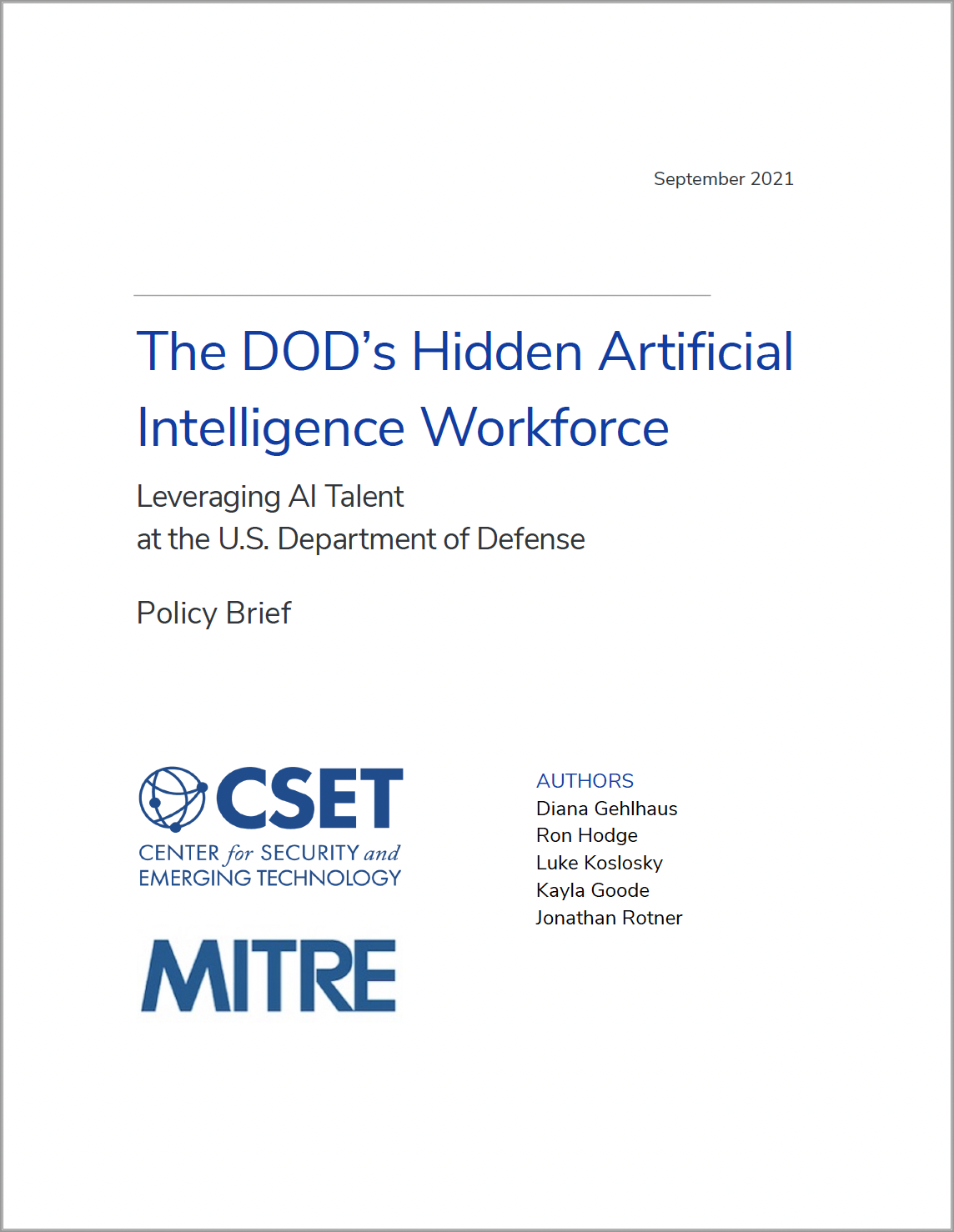Executive Summary
Cultivating a leading artificial intelligence workforce is a strategic focus of the U.S. Department of Defense’s (DOD) 2018 AI Strategy. That makes harnessing the full potential of AI for assured superiority and security critical, but it cannot happen in a vacuum. It requires a ready and able workforce, along with sustained pipelines and opportunities to leverage expertise. Recommendations from the National Security Commission on Artificial Intelligence’s Final Report echoed this need, stating that “national security agencies need more digital experts now or they will remain unprepared to buy, build, and use AI and its associated technologies.”
However, the DOD has publicly stated that it faces significant challenges in accessing AI talent. Adding to these challenges, the DOD has not consistently defined AI talent. The DOD’s AI workforce discussions have therefore had a narrow focus on recruiting select technical talent, namely software developers, lamenting an inability to compete with the private sector. The push to engage this talent includes campaigning to raise salaries, creating fellowships, and leveraging rotational exchanges with industry.
This policy brief provides a new perspective on this discussion. Instead of repeating how the DOD struggles to compete with the private sector, we argue that the DOD already has a hidden cadre of AI and related experts. We further argue that this hidden cadre could go a long way in meeting stated AI objectives, through policies that more effectively identify and leverage this talent, processes that incentivize experimentation and changes in career paths, and through investing in necessary technological infrastructure.
To better understand the current state of the DOD’s AI workforce, we conducted interviews with 31 experts across the services and the Office of the Secretary of Defense. We then analyzed civilian personnel data from the Office of Personnel Management (OPM), and leveraged key insights from previous CSET research.
Our analysis suggests that the DOD employs more AI talent than the popular narrative may suggest. Previous CSET research found the national security community was a top employer of AI talent, particularly technical talent. The interviews validated this hypothesis, as did our analysis of OPM data on the top occupation codes that likely include AI talent.
Our analysis also points to a range of reasons for why the DOD’s existing AI workforce remains hidden. Strategically, the services do not have a consistent approach to defining or prioritizing AI. This translates directly into the level of prioritization and investment put into cultivating an AI workforce. On a more tactical level, we find that challenges for identifying and leveraging AI talent fall into three general categories: people, processes, and technology.
Moreover, we find that each DOD armed service currently has a different approach to defining, identifying, classifying, assigning and tracking AI and AI-related talent. Approaches span informal networking and word-of-mouth recommendations; equating AI expertise with technically-oriented career fields or educational credentials; creating searchable skills repositories; and even a machine learning approach in which personnel files are scraped and analyzed for potential digital skills. Our discussions revealed many organic experiments taking place within each service to identify and leverage AI or related talent, from informal “communities of practice” to flyaway teams and new career pathways. Finally, experts had a range of opinions on what different services should do to cultivate a leading AI workforce that reflected their circumstances, realities, and requirements.
Based on these findings, we provide 15 recommendations to help the DOD better leverage its existing AI workforce. Our recommendations cover technical and nontechnical talent, apply to each of the services, are broken down by challenge, and are intentionally actionable on short- and medium-term timelines.
We begin with a recommendation that sets the strategic foundation, while the remaining recommendations map through the framework:
Identification → Experimentation → Implementation → Harmonization
Each step in the framework defines a phase for sustained talent management process change. First, identification of AI talent; second, experimentation, evaluation, and iteration of new initiatives designed to leverage AI talent; third, implementation of an agreed upon approach; and fourth, harmonization of service-level approaches to enable enterprise-wide AI talent assessment.
Our recommendations are designed to create agility in talent management. We believe AI, like other emerging technologies, demonstrates the need for services to adapt to new warfighting techniques and domains. Such agility includes aligning performance incentives; creating opportunities to build and leverage expertise; and, importantly, to track, evaluate, and iterate pilot initiatives. It also allows for flexibility across services without creating more seams as AI talent management is unlikely to look the same for each service. What may work well for one service may not for another, given inherent differences in approach to AI adoption, mission priorities, and force management.
Figure S1 provides a summary list of our recommendations. We propose talent management actions for the short term to leverage AI talent now and in the medium term to cultivate pipelines of expertise in the future. We also recommend targeted training from operators and acquirers to senior leaders, and rewarding “rock stars” that are uniquely positioned to make change happen.
Several of our recommendations are also specific to the Joint Artificial Intelligence Center in its role as the central hub and coordinator for the DOD’s AI activities. This includes repurposing outdated and underused two-digit function codes already assigned to every DOD billet for the AI archetypes, and to create a forum to harmonize service-level AI workforce initiatives and learned best practices.
This policy brief focuses on the DOD’s best asset: its existing workforce. We hope this report provides a new perspective to advance the DOD’s strategic goals. We recognize that some of our recommendations are intertwined with bigger issues that are difficult, time-consuming, and potentially costly to change. However, we believe that all of our recommendations are critical to effectively leveraging and sustaining the DOD’s AI workforce.
